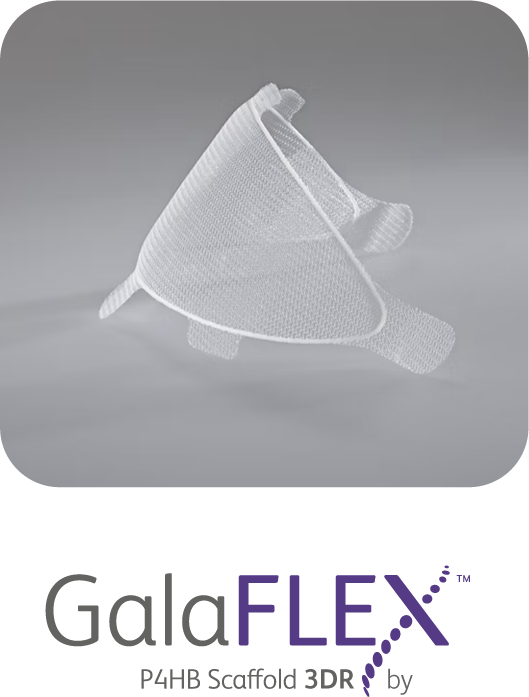Discover our portfolio
Clinical studies have shown that GalaFLEX™ Scaffold maintains the shape and position of the breast obtained after aesthetic breast surgery.25-27

INDICATIONS FOR USE:
GalaFLEX™ Scaffold is indicated for use as a bioresorbable scaffold for soft tissue support and to repair, elevate and reinforce deficiencies where weakness or voids exist that require the addition of material to obtain the desired surgical outcome. This includes reinforcement of soft tissue in plastic and reconstructive surgery, and general soft tissue reconstruction. GalaFLEX™ Scaffold is also indicated for the repair of fascial defects that require the addition of a reinforcing or bridging material to obtain the desired surgical result.
IMPORTANT SAFETY INFORMATION:
Possible complications following implantation of the GalaFLEX™, GalaFLEX 3D™, and GalaFLEX 3DR™ Scaffolds include infection, seroma, pain and swelling, scaffold migration, wound dehiscence, haemorrhage, adhesions, haematoma, inflammation, extrusion and recurrence of the soft tissue defect. In pre-clinical testing, the GalaFLEX™ Scaffold collection elicited a minimal tissue reaction characteristic of foreign body response to a substance. The tissue reaction resolved as the scaffold was resorbed. For complete prescribing information, including indications for use, warnings and precautions, and adverse events, consult the specific GalaFLEX™ Scaffold Product Instructions for Use.

INDICATIONS FOR USE:
GalaFLEX 3D™ Scaffold is indicated for use as a bioresorbable scaffold for soft tissue support and to repair, elevate and reinforce deficiencies where weakness or voids exist that require the addition of material to obtain the desired surgical outcome. This includes reinforcement of soft tissue in plastic and reconstructive surgery, and general soft tissue reconstruction. GalaFLEX 3D™ Scaffold is also indicated for the repair of fascial defects that require the addition of a reinforcing or bridging material to obtain the desired surgical result.
IMPORTANT SAFETY INFORMATION:
Possible complications following implantation of the GalaFLEX™, GalaFLEX 3D™, and GalaFLEX 3DR™ Scaffolds include infection, seroma, pain and swelling, scaffold migration, wound dehiscence, haemorrhage, adhesions, haematoma, inflammation, extrusion and recurrence of the soft tissue defect. In pre-clinical testing, the GalaFLEX™ Scaffold collection elicited a minimal tissue reaction characteristic of foreign body response to a substance. The tissue reaction resolved as the scaffold was resorbed. For complete prescribing information, including indications for use, warnings and precautions, and adverse events, consult the specific GalaFLEX™ Scaffold Product Instructions for Use.

INDICATIONS FOR USE:
GalaFLEX 3DR™ Scaffold is indicated for use as a bioresorbable scaffold for soft tissue support and to repair, elevate and reinforce deficiencies where weakness or voids exist that require the addition of material to obtain the desired surgical outcome. This includes reinforcement of soft tissue in plastic and reconstructive surgery, and general soft tissue reconstruction. GalaFLEX 3DR™ Scaffold is also indicated for the repair of fascial defects that require the addition of a reinforcing or bridging material to obtain the desired surgical result.
IMPORTANT SAFETY INFORMATION:
Possible complications following implantation of the GalaFLEX™, GalaFLEX 3D™, and GalaFLEX 3DR™ Scaffolds include infection, seroma, pain and swelling, scaffold migration, wound dehiscence, haemorrhage, adhesions, haematoma, inflammation, extrusion and recurrence of the soft tissue defect. In pre-clinical testing, the GalaFLEX™ Scaffold collection elicited a minimal tissue reaction characteristic of foreign body response to a substance. The tissue reaction resolved as the scaffold was resorbed. For complete prescribing information, including indications for use, warnings and precautions, and adverse events, consult the specific GalaFLEX™ Scaffold Product Instructions for Use.
References:
1.Williams, Simon F., David P. Martin, and Arikha C. Moses. “The History of GalaFLEX P4HB Scaffold.” Aesthetic Surgery Journal 36.Suppl 2 (2016): S33–S42. PMC. Web. 1 June 2017.
2.Deeken CR, Matthews BD. Characterization of the Mechanical Strength, Resorption Properties, and Histologic Characteristics of a Fully Absorbable Material (Poly-4-hydroxybutyrate-PHASIX Mesh) in a Porcine Model of Hernia Repair. ISRN Surg. 2013;2013:238067. Published 2013 May 28. doi:10.1155/2013/238067.
3.GalaFLEX™ Scaffold Instructions for Use.
4.Preclinical data on file. Results may not correlate to clinical outcomes.
5.No scaffold is indicated for use in contaminated or infected wounds.
6.Pineda Molina C, Giglio R, Gandhi RM, Sicari BM, Londono R, Hussey GS, et al. Comparison of the host macrophage response to synthetic and biologic surgical meshes used for ventral hernia repair. J Immunol Regen Med. (2019) 3:13–25.
7.Scott JR, Deeken CR, Martindale RG, Rosen MJ. Evaluation of a fully absorbable poly-4-hydroxybutyrate/absorbable barrier composite mesh in a porcine model of ventral hernia repair. Surg Endosc. 2016;30(9):3691-3701. doi:10.1007/s00464-016-5057-9.
8.Klinge U, Junge K, Spellerberg B, Piroth C, Klosterhalfen B, Schumpelick V. “Do multifilament alloplastic meshes increase the infection rate? Analysis of the polymeric surface, the bacteria adherence, and the in vivo consequences in a rat model.” J Biomed Mater Res. 2002;63(6):765-71.
9.Halaweish, Ihab, et al. “Novel in vitro model for assessing susceptibility of synthetic hernia repair meshes to Staphylococcus aureus infection using green fluorescent protein-labeled bacteria and modern imaging techniques.” Surgical infections 11.5 (2010): 449-454.
10.Engelsman, A. F., van der Mei, H. C., Ploeg, R. J., & Busscher, H. J. (2007). “The phenomenon of infection with abdominal wall reconstruction.” Biomaterials, 28(14), 2314-2327.
11.Deeken CR, Chen DC, Lopez-Cano M, Martin DP, Badhwar A. Fully resorbable poly-4-hydroxybutyrate (P4HB) mesh for soft tissue repair and reconstruction: A scoping review. Front Surg. 2023;10:1157661. Published 2023 Apr 12. doi:10.3389/fsurg.2023.1157661.